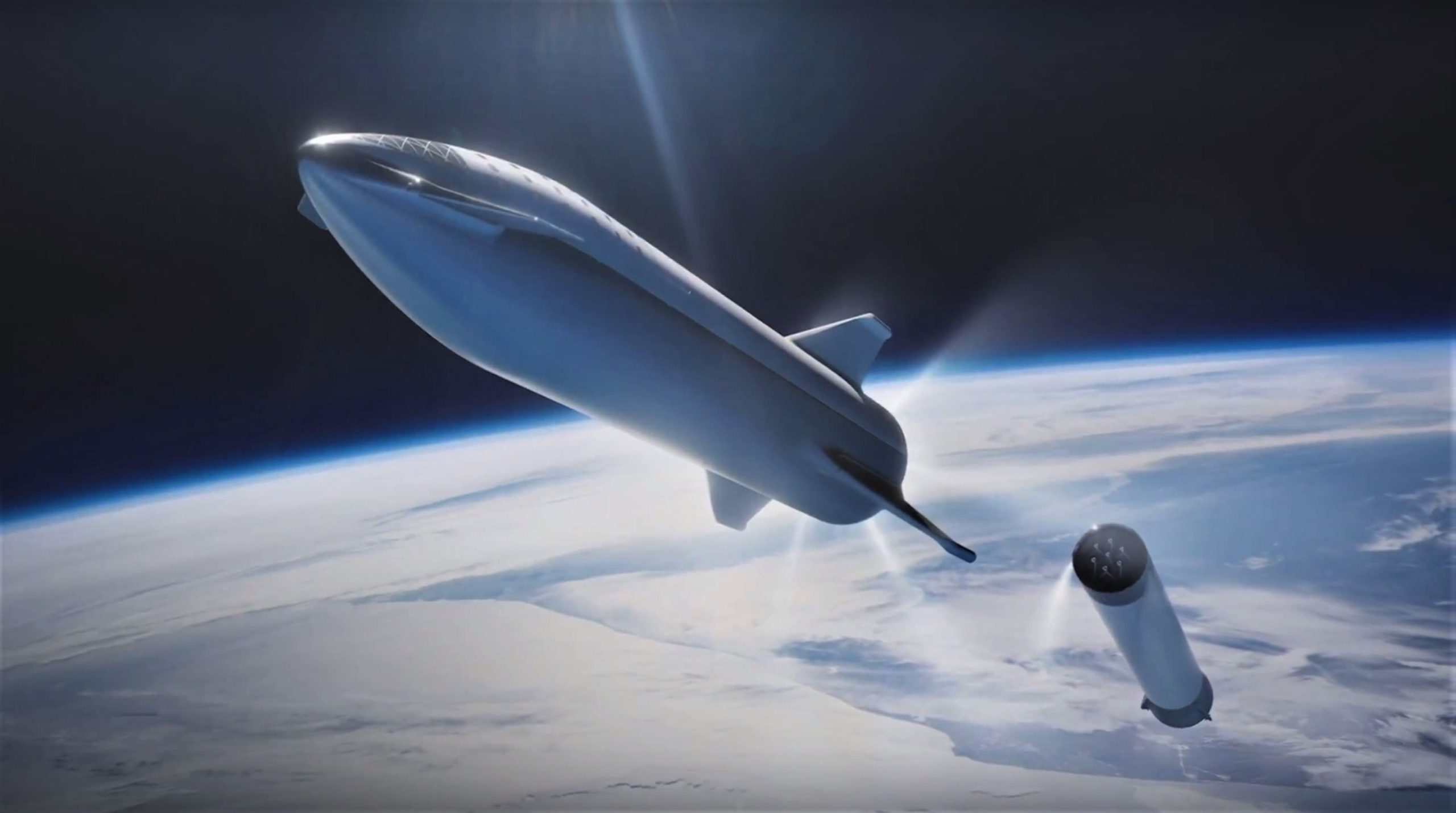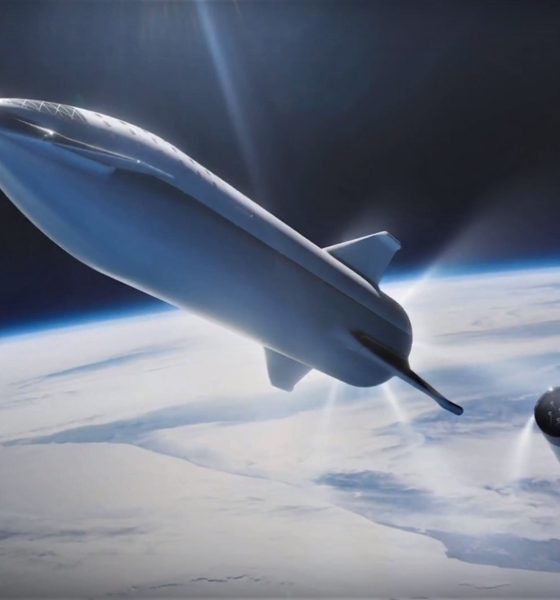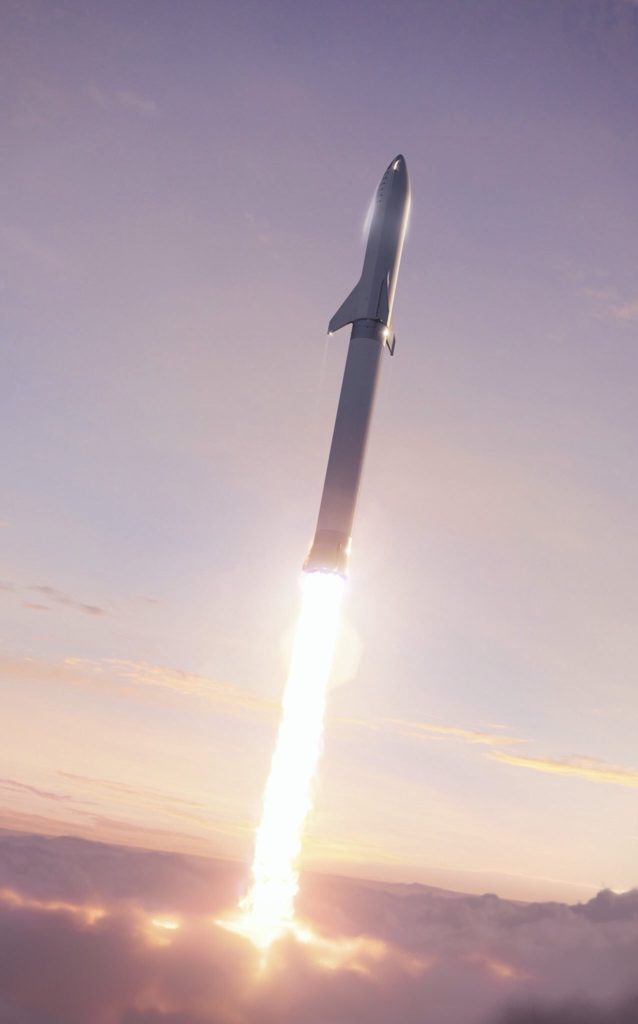

SpaceX
SpaceX’s BFR officially updated with new fins/legs, canard wings, and more
Speaking before a crowd of roughly 100 members of the press and even more SpaceX employees, CEO Elon Musk and lunar tourism customer Yusaku Maezawa presented and answered questions for more than an hour and a half, over the course of which Musk made public a number of updates to the company’s BFR booster and spaceship.
Maezawa, on the other hand, revealed a wholly unexpected plan for private lunar tourism deemed #dearMoon, built upon the goals of both (partially) funding development of BFR and placing a group of 6-8 international artists aboard a SpaceX spaceship for a journey around the Moon as early as 2023.
This is BFR from @spacex #dearMoon pic.twitter.com/jZiu1RHqUN
— 前澤友作 (@yousuck2020) September 18, 2018
Lacking no ambition, both BFR and #dearMoon have a vast amount of work to complete before their aspirations can be realized. Foundational to an unprecedented private voyage around the Moon, BFR is where this story begins, and SpaceX’s latest 2018 variation on the concept has departed from the 2017 vehicle’s design, with the majority of those changes centering around the upper-stage spaceship, known as BFS.
Those changes can generally be sorted into three main categories: new wings and fins, new operational strategies for spaceship landings, and new a Raptor engine layout.
- A full BFR booster and spaceship visualized during launch. (SpaceX)
- Rockets are perhaps even more capital intensive. (SpaceX)
- SpaceX’s 2018 BFR spaceship shows off new fins and forward canards, of which only the central tail fin is not an active control surface. (SpaceX)
Wings and fins
The most immediately visible difference between the spaceships of 2017 and 2018 can be found with both crafts’ aerodynamic surfaces and control implements. BFR (2018) now features three distinct fins in a tripod configuration, although Musk stated that the tail fin was scarcely a fin at all and essentially present for the sole purpose of being the third landing leg. Perhaps the most unusual feature of these new tripod fins is that the lower pair have been designed to be massive, agile control surfaces necessary for reentry and landing on planets or moons with significant atmospheres. Those three fins will simultaneously act as landing legs and critical control surfaces while operating in an atmosphere.
Additionally, BFR (2018) has been updated to include a pair of forward canards that will effectively act as a stand-in for grid fins on the spaceship, whereas the booster will simply have traditional titanium grid fins, judging from an official render of the full rocket. Compared with the delta wing or stubby winglets of 2016 and 2017 variants, BFR (2018) will have far more aerodynamic control authority, improving the versatility and stability of the vehicle during atmospheric reentry, flight, and landing on Mars, Saturnian moon Titan, and – most importantly – Earth.

Stay tuned for additional discussion of spaceship landings, changes to SpaceX’s Raptor engine strategy, and more later this week.
For prompt updates, on-the-ground perspectives, and unique glimpses of SpaceX’s rocket recovery fleet check out our brand new LaunchPad and LandingZone newsletters!

Elon Musk
SpaceX maintains unbelievable Starship target despite Booster 18 incident
It appears that it will take more than an anomaly to stop SpaceX’s march towards Starship V3’s refinement.

SpaceX recently shared an incredibly ambitious and bold update about Starship V3’s 12th test flight.
Despite the anomaly that damaged Booster 18, SpaceX maintained that it was still following its plans for the upgraded spacecraft and booster for the coming months. Needless to say, it appears that it will take more than an anomaly to stop SpaceX’s march towards Starship V3’s refinement.
Starship V3 is still on a rapid development path
SpaceX’s update was posted through the private space company’s official account on social media platform X. As per the company, “the Starbase team plans to have the next Super Heavy booster stacked in December, which puts it on pace with the test schedule planned for the first Starship V3 vehicle and associated ground systems.”
SpaceX then announced that Starship V3’s maiden flight is still expected to happen early next year. “Starship’s twelfth flight test remains targeted for the first quarter of 2026,” the company wrote in its post on X.
Elon Musk mentioned a similar timeline on X earlier this year. In the lead up to Starshp Flight 11, which proved flawless, Musk stated that “Starship V3 is a massive upgrade from the current V2 and should be through production and testing by end of year, with heavy flight activity next year.” Musk has also mentioned that Starship V3 should be good enough to use for initial Mars missions.
Booster 18 failure not slowing Starship V3’s schedule
SpaceX’s bold update came after Booster 18 experienced a major anomaly during gas system pressure testing at SpaceX’s Massey facility in Starbase, Texas. SpaceX confirmed in a post on X that no propellant was loaded, no engines were installed, and personnel were positioned at a safe distance when the booster’s lower section crumpled, resulting in no injuries.
Still, livestream footage showed significant damage around the liquid oxygen tank area of Booster 18, leading observers to speculate that the booster was a total loss. Booster 18 was among the earliest vehicles in the Starship V3 series, making the failure notable. Despite the setback, Starship V3’s development plans appear unchanged, with SpaceX pushing ahead of its Q1 2026 test flight target.
Elon Musk
SpaceX issues statement on Starship V3 Booster 18 anomaly
The incident unfolded during gas-system pressure testing at the company’s Massey facility in Starbase, Texas.

SpaceX has issued an initial statement about Starship Booster 18’s anomaly early Friday. The incident unfolded during gas-system pressure testing at the company’s Massey facility in Starbase, Texas.
SpaceX’s initial comment
As per SpaceX in a post on its official account on social media platform X, Booster 18 was undergoing gas system pressure tests when the anomaly happened. Despite the nature of the incident, the company emphasized that no propellant was loaded, no engines were installed, and personnel were kept at a safe distance from the booster, resulting in zero injuries.
“Booster 18 suffered an anomaly during gas system pressure testing that we were conducting in advance of structural proof testing. No propellant was on the vehicle, and engines were not yet installed. The teams need time to investigate before we are confident of the cause. No one was injured as we maintain a safe distance for personnel during this type of testing. The site remains clear and we are working plans to safely reenter the site,” SpaceX wrote in its post on X.
Incident and aftermath
Livestream footage from LabPadre showed Booster 18’s lower half crumpling around the liquid oxygen tank area at approximately 4:04 a.m. CT. Subsequent images posted by on-site observers revealed extensive deformation across the booster’s lower structure. Needless to say, spaceflight observers have noted that Booster 18 would likely be a complete loss due to its anomaly.
Booster 18 had rolled out only a day earlier and was one of the first vehicles in the Starship V3 program. The V3 series incorporates structural reinforcements and reliability upgrades intended to prepare Starship for rapid-reuse testing and eventual tower-catch operations. Elon Musk has been optimistic about Starship V3, previously noting on X that the spacecraft might be able to complete initial missions to Mars.
Elon Musk
SpaceX Starship Version 3 booster crumples in early testing
Photos of the incident’s aftermath suggest that Booster 18 will likely be retired.

SpaceX’s new Starship first-stage booster, Booster 18, suffered major damage early Friday during its first round of testing in Starbase, Texas, just one day after rolling out of the factory.
Based on videos of the incident, the lower section of the rocket booster appeared to crumple during a pressurization test. Photos of the incident’s aftermath suggest that Booster 18 will likely be retired.
Booster test failure
SpaceX began structural and propellant-system verification tests on Booster 18 Thursday night at the Massey’s Test Site, only a few miles from Starbase’s production facilities, as noted in an Ars Technica report. At 4:04 a.m. CT on Friday, a livestream from LabPadre Space captured the booster’s lower half experiencing a sudden destructive event around its liquid oxygen tank section. Post-incident images, shared on X by @StarshipGazer, showed notable deformation in the booster’s lower structure.
Neither SpaceX nor Elon Musk had commented as of Friday morning, but the vehicle’s condition suggests it is likely a complete loss. This is quite unfortunate, as Booster 18 is already part of the Starship V3 program, which includes design fixes and upgrades intended to improve reliability. While SpaceX maintains a rather rapid Starship production line in Starbase, Booster 18 was generally expected to validate the improvements implemented in the V3 program.
Tight deadlines
SpaceX needs Starship boosters and upper stages to begin demonstrating rapid reuse, tower catches, and early operational Starlink missions over the next two years. More critically, NASA’s Artemis program depends on an on-orbit refueling test in the second half of 2026, a requirement for the vehicle’s expected crewed lunar landing around 2028.
While SpaceX is known for diagnosing failures quickly and returning to testing at unmatched speed, losing the newest-generation booster at the very start of its campaign highlights the immense challenge involved in scaling Starship into a reliable, high-cadence launch system. SpaceX, however, is known for getting things done quickly, so it would not be a surprise if the company manages to figure out what happened to Booster 18 in the near future.












